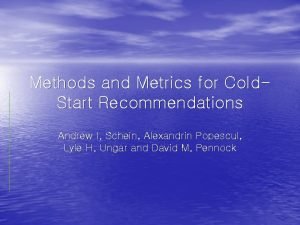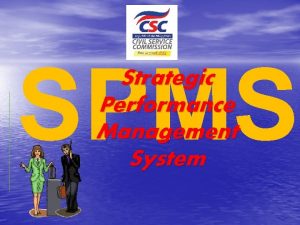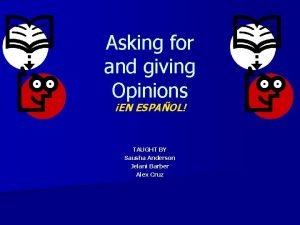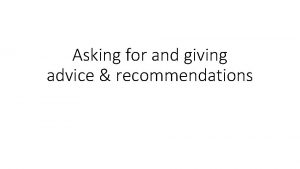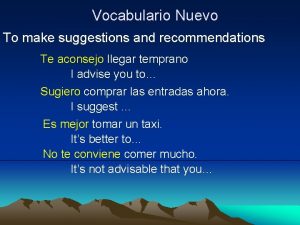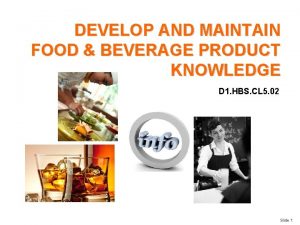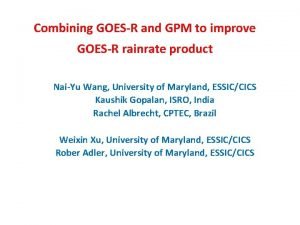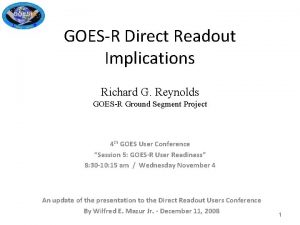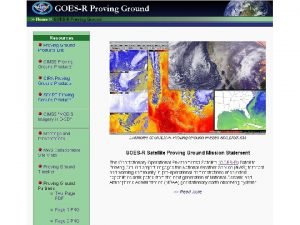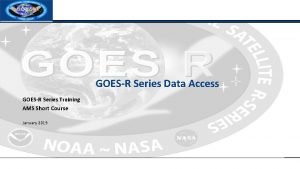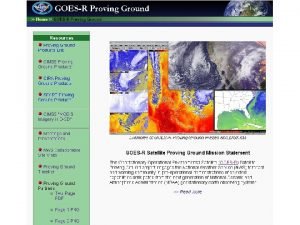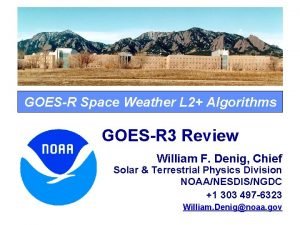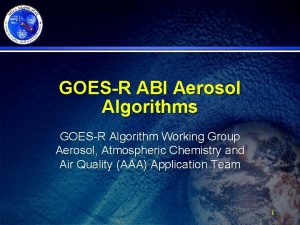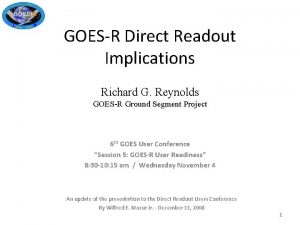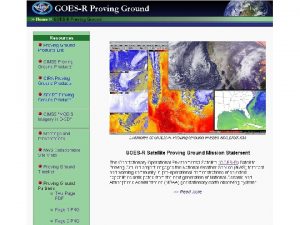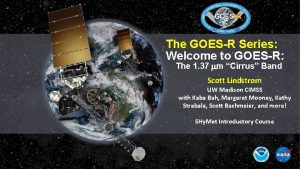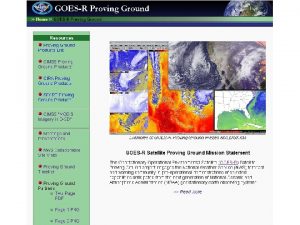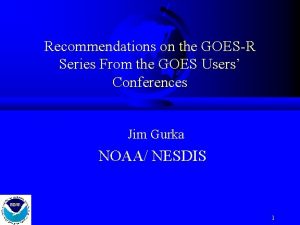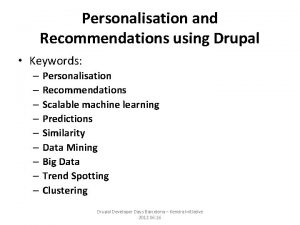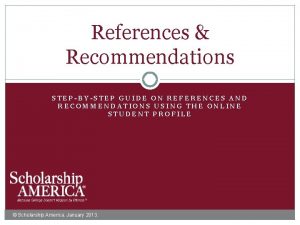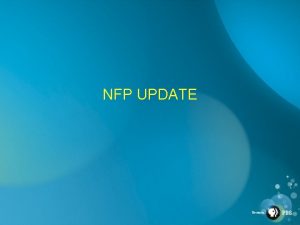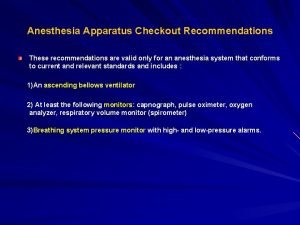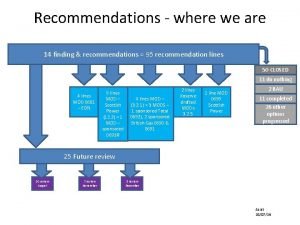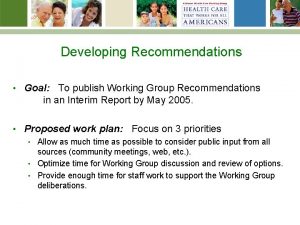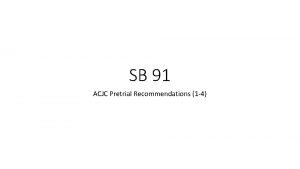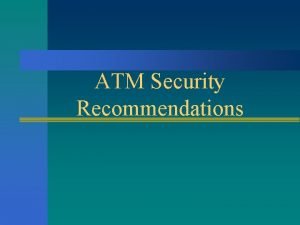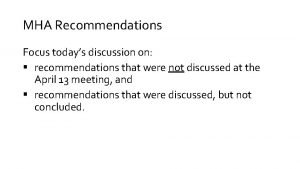GOESR Program Update and Recommendations from the GOESR


































- Slides: 34

GOES-R Program Update and Recommendations from the GOES-R Users’ Conferences Jim Gurka Tim Schmit NOAA/ NESDIS 2 nd MTG User Consultation Workshop, Locarno Switzerland, 13 -15 April, 2005

GOES-R Mission · Satisfies national operational environmental requirements for 24 -hour observation of weather, earth’s environment, and solar & space environment – · Supports all NOAA Mission Goals GOES continuously maintains operational satellites at two locations (75º West and 135º West) – On-orbit spare ready in case of failure · GOES-I Series current operational series · GOES-N Series under contract – · GOES-N launch: May 4, 2005 GOES-R Series is the follow-on program to GOES-N Series Integrated end-to-end system to achieve NOAA Goals 2

Distributed Architecture Concept Notional Baseline WEST A-Sat ABI SIS GLM service – – – EAST B-Sat HES SEISS services A-Sat ABI SIS GLM services B-Sat HES SEISS services Advanced Baseline Imager (ABI) Hyperspectral Environmental Suite (HES) Solar Imaging Suite (SIS) Space Environmental In-Site Suite Geostationary Lightning Mapper (GLM) 3

Mapping Requirements To System Solutions Instruments OAR NOS NMFS NMAO NESDI S Hyperspectral Environmental Suite (HES) Solar Imaging Suite (SIS) Clouds GPRD Precipitation Atmospheric Profiles Atmospheric Radiance Atmospheric Winds Land Ocean Coastal Waters & Estuaries Space & Solar MRD Space Env In-Situ Suite (SEISS) GOES Lightning Mapper (GLM) GOES-R System Microwave Sounder/Imager Coronagraph Hyperspectral Imager Solar Irradiance Sensor Potential P 3 I PPI Adv. Baseline Imager (ABI) Aerosols Ecosystems, Weather & Water, Climate, Commerce & Transportation Other Users NWS Requirements Baseline Instruments NOAA Users 4

GOES-R Observational Requirements Aerosol Detection Aerosol Particle Size Suspended Matter Volcanic Ash Aircraft Icing Threat Cloud Imagery Cloud & Moisture Imagery Cloud Base Height Cloud Layers / Heights & Thickness Cloud Ice Water Path Cloud Liquid Water Cloud Optical Depth Cloud Particle Size Distribution Cloud Top Phase Cloud Top Height Cloud Top Pressure Cloud Top Temperature Cloud Type Convection Initiation Enhanced "V"/Overshooting Top Detection Hurricane Intensity Imagery: All-Weather / Day - Night Surface Albedo Surface Emissivity Vegetation Fraction Vegetation Index Atmospheric Vertical Moisture Profile Atmospheric Vertical Temperature Profile Capping Inversion Information Currents Ocean Color Ocean Optical Properties Ocean Turbidity Sea & Lake Ice / Displacement & Direction Sea & Lake Ice / Age Sea & Lake Ice / Concentration Sea & Lake Ice / Extent & Characterization Derived Stability Indices Moisture Flux Pressure Profile Total Precipitable Water Total Water Content Clear Sky Masks Radiances Absorbed Shortwave Radiation Downward Longwave Radiation Downward Solar Insolation Reflected Solar Insolation Upward Longwave Radiation CO Concentration Ozone Total SO 2 Detection Derived Motion Winds Lightning Detection Low Cloud & Fog Turbulence Visibility Geomagnetic Field ABI – Advanced Baseline Imager Dust/Aerosol Probability of Rainfall Potential Rainfall Rate Microburst Wind Speed Potential Fire / Hot Spot Imagery Flood / Standing Water Land Surface (Skin) Temperature HES – Hyperspectral Environmental Suite SEISS – Space Env. In-Situ Suite SIS – Solar Instrument Suite Sea & Lake Ice / Extent & Edge Sea & Lake Ice / Surface Temp Sea & Lake Ice / Motion Sea & Lake Ice / Thickness Ice Cover / Landlocked Snow Cover Snow Depth Sea Surface Temps Energetic Heavy Ions Mag Electrons & Protons: Low Energy Mag Electrons & Protons: Med & High Energy Solar & Galactic Protons Solar Flux: EUV Solar Flux: X-Ray Solar Imagery: X-Ray GLM – GOES Lightning Mapper Magnetometer 5

System Improvement Highlights · Simultaneous Hemisphere/Mesoscale Coverage – Southern Hemispheric coverage retained during Mesoscale · Timeliness – Improved refresh rates and data latency · Instrument Performance – Improved spatial resolution and spectral response · Mission Continuity – 10 year design life per spacecraft 6

Instrument Improvement Highlights GOES-N Instruments GOES-R Notional Baseline Imager Advanced Baseline Imager (ABI) 5 Channels 16 Channels Multispectral Sounder 18 Channel Solar X Ray Imager Hyperspectral Environmental Suite (HES) 1500 Channel Sounder 14 Channel Imager Solar Imaging Suite (SIS) (Dynamic Range, Resolution, Sensitivity) Space Environmental Monitor Space Environmental In-Situ Suite (SEISS) (Radiation Environmental Response Times) N/A Geostationary Lightning Mapper (GLM) 7

Ground Improvement Highlights GOES-N GOES-R Sensor Data Processing 2. 6 Mb Downlink >120 Mb Downlink Products 41 ~160 Redundancy CDA (Wallops Island, VA SOCC/PG (Suitland, MD) CDA B/U GSFC (Greenbelt, MD) CDA (Wallops Island, VA MM/PG/PD (Suitland, MD) MM/PG/PD/CDAS (Site TBD) _ Increased automation Operational Efficiency 8

Services · GOES-R Re-Broadcast (GRB) – Processed data, environmental info rebroadcast to users · Auxiliary Payload Services – Direct Communication Services (DCS) – Emergency Managers Weather Information Network (EMWIN) – Low Rate Information Transmission (LRIT) – Search and Rescue Satellite Aided Tracking (SARSAT) – NOAA Marine and Aviation Operations (NMAO) Aircraft and Ship Service 9

GOES-R Program Schedule As of: 22 Mar 05 10

GOES-R Program Requirements Document (GPRD) Next Steps · June 2005: Scrub Solar, Space Weather, and Lightning requirements · June 2005: Provide plan for comprehensive review, validation and risk reduction for all products, data distribution, and user readiness requirements for GPRD II · Fall 2005: Draft GPRD Ia including: P 3 I assessment, incorporation of BAA studies, and HES, SIS and SEISS formulation contract feedback · Fall 2005: Initiate transformation of Line Office requirements to NOAA Program requirements · Spring 2006: Draft GPRD II with NOAA Program requirements update · Summer 2006: GPRD II comprehensive approval and validation process · Fall 2006: Final GPRD II Released 11

Outline – 1 st two GOES Users’ Conferences • Brief summary • Impact • Access to reports – 3 rd GOES Users’ Conference • Goals • User Recommendations • For more information…. 12

1 st Two GOES Users’ Conferences – May 22 – 25, 2001 (I) – Oct. 1 – 3, 2002 (II) • Boulder, CO: NIST Auditorium • Approximately 200 participants each conf. - Government Commercial interests Academia Scientific organizations International 13

Impact of 1 st Two Conferences: – Baseline instruments include: • • • A 16 -channel imager Much improved spatial and temporal resolution An IR sounder 5 times faster than present sounder An IR Sounder with 4 km footprint and flexible modes A lightning mapper All visible and IR channels will be calibrated – P 3 I Instruments include: • A microwave sounder • A microwave imager 14

Third Conference: – May 10 – 14, 2004 – Broomfield, CO (Omni Hotel) – Open to entire GOES User Community • Domestic and international – 300+ participants – For updated information and access to reports: • http: //www. osd. noaa. gov/announcement/index. htm 15

GOES-R Users’ Conferences: – European participation in all 3 • European requirements are documented in GPRD-I 16

Third Conference: – Goals: • Inform users on status of plans for GOES-R constellation, instruments and operations • Refine potential user applications for data and products • Help user community prepare for GOES-R • Address user and societal benefits • Continue to improve communication between NOAA and user communities 17

Third Conference: – Recommendations provided on: • Risk reduction • Data distribution, management, and archive • Education and training • Climate observation issues • Communication between NOAA and user communities 18

Recommendations on Risk Reduction: – Provide test data sets well in advance of operations; – Leverage NPP synergy and experiences; – Develop and validate new or improved products before launch; – Form expert teams for each core sensor; • Involve the end users at the local level – Re-package products to support multiple levels of users; 19

Recommendations on Risk Reduction: – Engage existing organizations (i. e. JCSDA); – Establish a focused coastal and ocean user group; – Use simulated data sets to test and validate data processing and distribution systems; – Ensure sufficient overlap with GOES-N series for in orbit validation; – Organize a coordinated field campaign to use in-situ measurements for validation; – GOES-R system should be tested end-to-end before launch; 20

Data and Product Distribution: • Data and products must be easily accessible, free, and easily processed through a userfriendly interface in real time; - Including raw data for re-processing • NOAA must consider a wide variety of user needs and capabilities; - Some users may need all the information, but not all the data; 21

Data and Product Distribution: • GOES Re-Broadcast (GRB) should be one component of data and product distribution; • Full solution set should allow for future advances in communications technology; • NOAA should balance U. S. needs with International user needs; • Need seamless transition from GOES N-P series; • Users need rapid access to “thumbnails” of available products across all systems and platforms; 22

Data Distribution, Management and Archive : – Managing the increase in data volume: • Increased volume requires sophisticated archiving (CLASS) B Archiving metadata and data levels 1 -3 are important • Metadata must include: 1. Geospatial information 2. Acquisition time 3. Information on product accuracy and stability 4. Information on sensors and collection platforms 5. Information on algorithms used for product generation 23

Education and Training : – Primary Goal: Ensure that all data are fully utilized immediately following start of operations • Major training venues: Schools, universities, workshops, conferences, online; • Training must be tailored to meet unique user needs: - NWS forecasters FAA meteorologists Coastal service centers Broadcast meteorologists University faculty Commercial and industry International Climatologists Numerical modelers (weather, climate, air quality, oceans) 24

Education and Training : – Use proving ground concept similar to WSR-88 D • Station extra personnel at: - Selected NWS forecast offices - Coastal service centers - National centers – COMET should be used to provide education for professional meteorologists, oceanographers, and climatologists; • Learn from what EUMETSAT has accomplished in online documentation for image interpretation 25

Climate Issues : – Calibration is critical: • Onboard, cross sensor, cross satellite • Pre-launch, post-launch, and re-calibration during long periods as on-orbit spare • NOAA should organize workshops to engage the domestic and international communities to ensure that scientific and long-term stability requirements are met 26

Climate Issues : – Data Access and Reprocessing: • Need access to: - original data for reprocessing - instrument and performance monitoring data - Information on instrument stability, uncertainty and errors within the measurements - Data in a user friendly format that can be accessed with COTS software • CDRs should be generated using a separate CDR system (per recommendation of NAS Study) 27

Climate Issues : – Education: • Training programs, such as COMET should be expanded to include climate modules; • Climate community should be educated and trained to use GOES-R climate and products in synergy with other satellites and “in situ” derived climate products. 28

Climate Issues : – Climate Risk Reduction: • Begin production on near real-time CDRs to monitor the current state of climate and short term variations; • Plan for reprocessing, archiving, and distribution of CDRs to create long-term records that are a consistent, seamless, high quality time series with minimized bias; • Establish a test bed for all components of the end-to-end GOES system, from acquisition to archive; 29

Third Conference Recommendations: – Expand User Input Opportunities: • More and different forums - Continue GOES Users’ Conferences - Presentations and special sessions at conferences - Focus groups linking users and developers to explore: • Data requirements; reprocessing needs; etc 30

Third Conference Recommendations: – Expand User Input Opportunities: • Continue interaction with users on: - Algorithm development - Requirements definition and clarification - Updates on programmatic and technical issues on GOES-R ( funding, development progress, design modifications) • Unified program Information - Create central location for GOES Program information (news; reference materials; webbased tutorials) 31

Plans for the Fourth GOES-R Users’ Conference: · Planned for May 1 -4 2006: – Location: Broomfield CO – Will focus on User Readiness 32

Summary: – The first two GOES-R Users’ Conference have had major impacts on GOES-R baseline – Focus on the Third Conference moved away from instrument needs to applications, benefits, and user readiness for GOES-R • Poster session was a hit…over 60 posters presented – 4 th Conference to continue focus on user readiness. 33

Summary: – For more info: • http: //www. osd. noaa. gov/announcement/index. htm Thank You to all participants of the GOES-R Users’ Conferences and contributors to the GPRD-I who provided their ideas on how to ensure that GOES-R will be a success! 34
 Alternative of log based recovery
Alternative of log based recovery Methods and metrics for cold-start recommendations
Methods and metrics for cold-start recommendations Opcr sample for lgu
Opcr sample for lgu Etranslat
Etranslat Asking for advice situations
Asking for advice situations Making suggestions and recommendations
Making suggestions and recommendations Lamb to the slaughter conclusion
Lamb to the slaughter conclusion Basic food and beverage knowledge
Basic food and beverage knowledge Hình ảnh bộ gõ cơ thể búng tay
Hình ảnh bộ gõ cơ thể búng tay Lp html
Lp html Bổ thể
Bổ thể Tỉ lệ cơ thể trẻ em
Tỉ lệ cơ thể trẻ em Voi kéo gỗ như thế nào
Voi kéo gỗ như thế nào Thang điểm glasgow
Thang điểm glasgow Chúa yêu trần thế alleluia
Chúa yêu trần thế alleluia Các môn thể thao bắt đầu bằng tiếng bóng
Các môn thể thao bắt đầu bằng tiếng bóng Thế nào là hệ số cao nhất
Thế nào là hệ số cao nhất Các châu lục và đại dương trên thế giới
Các châu lục và đại dương trên thế giới Công của trọng lực
Công của trọng lực Trời xanh đây là của chúng ta thể thơ
Trời xanh đây là của chúng ta thể thơ Cách giải mật thư tọa độ
Cách giải mật thư tọa độ Làm thế nào để 102-1=99
Làm thế nào để 102-1=99 độ dài liên kết
độ dài liên kết Các châu lục và đại dương trên thế giới
Các châu lục và đại dương trên thế giới Thể thơ truyền thống
Thể thơ truyền thống Quá trình desamine hóa có thể tạo ra
Quá trình desamine hóa có thể tạo ra Một số thể thơ truyền thống
Một số thể thơ truyền thống Cái miệng xinh xinh thế chỉ nói điều hay thôi
Cái miệng xinh xinh thế chỉ nói điều hay thôi Vẽ hình chiếu vuông góc của vật thể sau
Vẽ hình chiếu vuông góc của vật thể sau Nguyên nhân của sự mỏi cơ sinh 8
Nguyên nhân của sự mỏi cơ sinh 8 đặc điểm cơ thể của người tối cổ
đặc điểm cơ thể của người tối cổ Thế nào là giọng cùng tên? *
Thế nào là giọng cùng tên? * Vẽ hình chiếu đứng bằng cạnh của vật thể
Vẽ hình chiếu đứng bằng cạnh của vật thể Tia chieu sa te
Tia chieu sa te Thẻ vin
Thẻ vin

